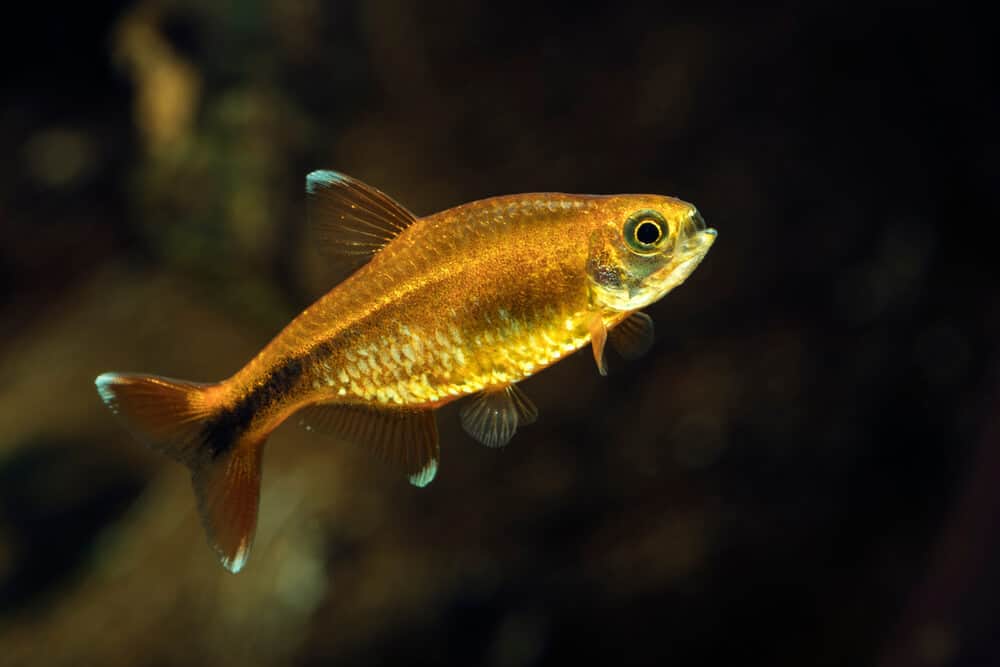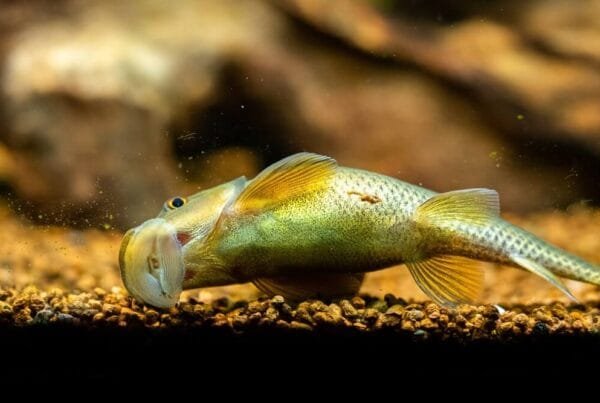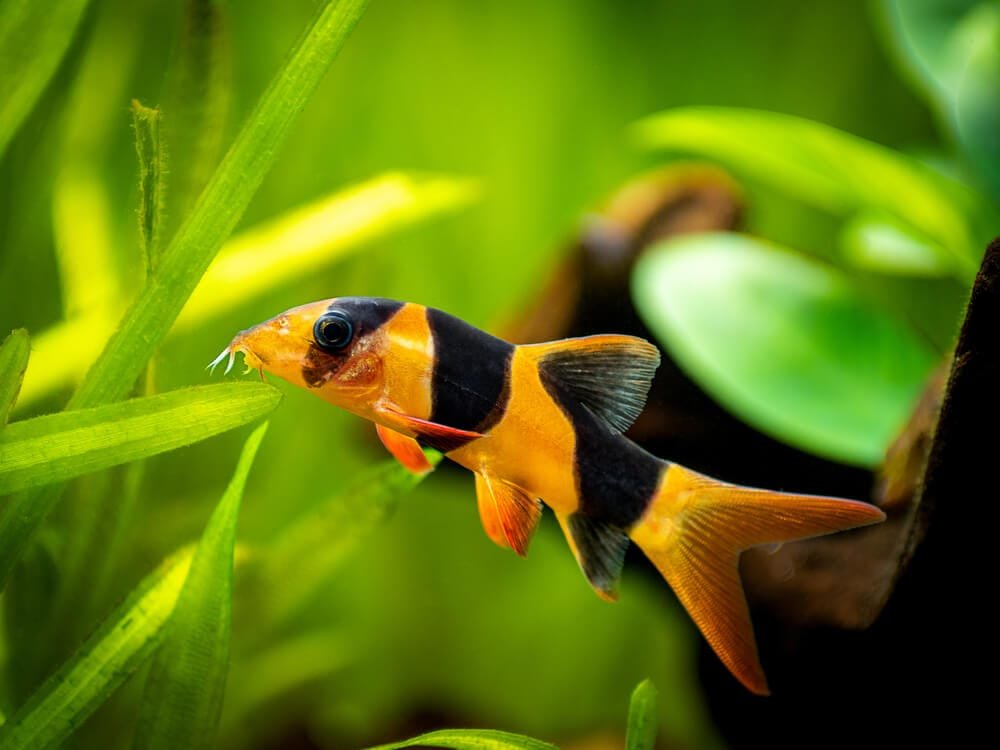Silver Tip Tetra, scientifically known as Hasemania nana, is a gorgeous freshwater fish popular for its golden color and silver-tipped fins.
They belong to the Characidae family and share some traits with the neon tetra species. The Silvertips are social creatures that thrive well among similar species.
In this ultimate fish care guide, you will learn everything about the fish lifespan, diet, tank setup, tank mates, and more. Knowing how to care for the Silvertip Tip Tetra species in the right conditions makes them a gem to own.
Species Overview
Common Names: Silver Tip Tetra
Scientific Name: Hasemania nana
Adult Size: 2 inches
Life Expectancy: 5 – 8 years
Characteristics
Family: Characidae
Origin: South America, São Francisco basin in Brazil
Social: Peaceful and suitable for a community tank
Tank Level: Mid-water
Minimum Tank Size: 10 Gallons
Diet: Omnivore
Breeding: Egg Scatterer
Care: Easy
pH: 6.0 – 8.0
Hardness: 4 – 8 dKH
Temperature: 72 to 82 degrees F
Origin
Silver Tip Tetras are widespread in the São Francisco basin in Brazil and endemic to small streams and tributaries in South America. Regardless, they have a wide distribution in the white and blackwater brooks.
As shoaling and schooling fish species, Silvertips are super active in large social gatherings. They create an enjoyable, incredible gleaming wave in a large aquarium.
When it comes to feeding, they are not selective as they are omnivorous. They are also sometimes found resting in soft, sandy substrates, exploring through the foliage.
Lifespan
Silver Tips with great care typically live around five to eight years. However, many factors usually influence how long these freshwater fish species stay alive.
The first and major factor is genetics, then the level of care you give them. Having good husbandry is crucial to keeping them stress-free and active and essentially letting them live longer.
Average Size
Naturally, most silver tips, regardless if they’re male or female, don’t exceed 1.2 inches in length. This makes them smaller fishes in the size range.
But in rare cases, fully grown Silvertips can reach up to two inches. At this stage, the size of the Silvertip is likely a combination of good genes, incredible care, and some luck.
Appearance
Just like other species in the Characidae family, the Silver Tip Tetra has a body shape similar to the iconic torpedo’s body. Their silhouette looks so much like that of cardinal tetra and neon tetra.
They also differ from other species in the same family in terms of fins. In addition, they do not have the adipose fin behind the dorsal fin.
Male Silver Tips have semi-transparent deep copper color. The coppery sheen reflects glamorous light in most conditions.
Female Silvertips have a slight yellow undertone that is not so bright but looks much like silver. Also, their overall shape is a bit larger with a plumper belly.
Similarly, both the males and females are exhibiting golden yellow fins. The tips of each fin have bright silver dots – where their name comes from.
Silvertips have a striking black mark on the base of their tailfin. The mark extends into the caudal fork and is fringed on both sides of the caudal fork by a drop of yellow.
The Silvertip species is an elegant sight to behold. Their outstanding physical details make them more attractive than other tetra species.
Besides that, their widespread coppery sheen becomes more stunning as they’re able create a uniform shoal color in large groups.
Typical Behavior And Temperature
Typically, Silvertips are healthy species and they like to gather in groups with other fishes. However, as active and social as they are, they become uncomfortable in a group without enough space.
Housing Silvertips in schools of at least six or seven with similar species will make them happy. If it is possible to have a shoal of 10 or more, that would be great.
Make sure they are kept in an aquarium that is appropriately sized for the school. There should also be about three gallons of water per fish.
They become very aggressive when kept alone or in small numbers. This is because they are a lot happier when they’re able to explore the tank accompanied by other fish.
Preventing them from staying together exposes them to the constant fear that can shorten their lifespan.
In general, Silvertips are known to be more aggressive than other tetra species. They have the habit of oppressing other fishes by biting their fins, even in large groups.
They usually target long-finned species; however, they also bite any fish that mistakenly cross their path. But with careful planning or using a large tank, that behavior can be controlled.
Silver Tips are very active during the day, and as such, they are either found hiding in the vegetation or eating and swimming in the middle area of the tank.
When it is dark, they rest on the sandy substrate of the aquarium bottom. Their color becomes more slippery when they sleep.
Whenever they want to eat, they prefer the middle of the aquarium, not the top or bottom. They feed on foods that float in the water before sinking to the bottom of the aquarium.
Silver Tip Tetra Care
The process involved in taking care of Silvertips is relatively easy. Being one of the most resilient fishes in the industry, they can adapt to any standard tropical conditions.
They are generally undemanding but have some behavioral quirks and preferences that require constant attention for them to flourish. The following care guidelines will help you start on the right foot.
Tank Size
The fish species do not need a huge tank to stay healthy due to their small size. A standard 10-gallon tank is enough to accommodate a small group of tetras.
But for the best results, start with a 20-gallon tank size instead.
With a 20-gallon tank, a small shoal should be able to live comfortably without any problem. But for every adult Silvertips that you plan to keep, provide about 30 gallons to support their lifestyle.
Better still, if you want all your fishes in one place as one community or you plan to own a big group, simply scale up your tank.
Water Parameters
Because they are from South America’s warm waters, this makes them an epitome of tropical fish. Their ability to adapt to standard conditions makes them do well in captivity.
The most essential factors about these fish are warm water, low hardness, and neutral pH. Check out the best water parameters below:
- Ideal Water temperature: 72°F to 82°F
- Water hardness: 2–15 dGH
- pH levels: 6.0 to 8.0 (Aim for 7 – neutral)
Use a reliable aquarium test kit to check the parameters regularly because one of the most important care is to maintain standard water quality always.
Tank Setup
Recreating a natural habitat in a tank is the best thing you can offer a fish. Even if not 100% perfect, it should be as close as possible.
This statement is true for Silver Tips. Be creative with their habitat so they can be fulfilling living there.
To create their environment, start with a layer of a fine sand substrate that is very close to a natural riverbed.
It is also safe and favorable for other bottom feeder fishes you might add later.
Add some pieces of driftwood and rocks on top of the fine substrate material. You can also throw a few Indian almond leaves on the substrate.
This will not only reproduce the plant residue but the tannins will infuse the water to make it better.
Silvertip species are not exposed to plants in the wild, so you can add some plants too. Fallen plant leaves and twigs usually fill their natural habitat, rather than lush vegetation.
It is preferable to use hard fine leaf plants because the fishes seem to like having some plant coverage. The plants also act as a place to hide and play.
You need to understand that these fishes are known for nipping leaves. While the damage is usually not much, the best course of action is to go with a moderately strong plant.
Lighting
Lighting setup is another aspect of the care you need to consider. In most cases, Silvertips perform best in dim lights.
While the dim light may cause your tank to appear a bit dark, the fish will still be visible due to their shining golden yellow color.
They appear stunning in the aquarium as their body reflects light. Their color even looks more vibrant in the dark substrate, making your tank look fantastic.
Unfortunately, dim lights are not good for plants. So you should consider using light that is helpful for your plants.
Aquarium Water Filter
The importance of a filter in an aquarium is another significant feature you need to keep in mind. The aquarium water filter will help you maintain aeration and water quality.
Additionally, the filter will help clean your tank and still maintain the nitrogen cycle in the aquarium. Nitrobacter bacteria and Nitrifying bacteria will help break down the toxic ammonia and nitrite in your aquarium.
This makes your tank a safe place for your fish.
Decorations
Decorations will propel you to use bright lighting, this is somewhat contrary to the lifestyle of the freshwater fish. Therefore, you should use other decorations that can offer hidden places for the fish when the light is turned on.
A good idea is to include driftwood, rocks, and caves in the tank. These will not only become safe corners for the fish but also make the tank look glamorous.
The application of this concept will make the fishes and plants thrive reasonably.
Common Diseases
Silvertips, like any other fish, are susceptible to diseases that thrive in murky water. Normally, they do not have any unusual health issues but they are susceptible to conventional tropical fish ailments.
Neon tetra disease, velvet disease, fungal infection, gill parasites, fin rot, and ich are some of the diseases that these species can develop.
Neon Tetra Disease
Silvertips are infected with neon tetra disease when they eat a portion of food contaminated with parasites. An example of such food is dead fish, and the first visible symptom is restlessness.
Presently, there is no cure for neon tetra disease. Quickly separating and removing the affected fish from the tank will ensure all fish are not lost.
Also, buy high-quality foods and ensure the fish are not sick when buying them.
Fungal Infection
The major cause of fungal infection is bad water. Affected fish should be treated quickly by ensuring there is clean water in the tank.
Adding tablets to the water will also eliminate infections. These precautions will prevent other fishes from becoming infected too.
Mucous Membrane and Gill Parasite
These parasites are caused by single-cell organisms such as Costia, Trichodina, and Chilodonella. Symptoms are not usually obvious.
The best prevention for Mucus Membrane and Gill Parasite is to make sure that your tank water is clean. If you suspect any infection, ask a Silvertip expert or vet for the best medication.
Fortunately, these common diseases can be treated with effective quarantining and some over-the-counter medication.
Constantly staying on top of water conditions can help avoid these diseases altogether. Besides, Silver Tips are tough to resist disease on their own in great water conditions.
In a situation where water conditions fluctuate regularly, the fish can become stressed. The bacteria and parasites causing disease will also flourish in such water conditions.
At this stage, their immune system becomes weak and works against them. As such, they cannot fight off diseases.
To keep diseases at bay, test water parameters regularly and change the water weekly.
Food And Diet
In terms of feeding, Silver Tips belong to omnivores. They feed on plant detritus, insects, and anything else they can find in the wild.
It’s essential to provide them with a high-quality diet with different varieties in captivity.
Provide dry granules or premium flakes into the base of the fish meals. Feed them with nutritious balanced recipes or formulas that will project their color vibrancy.
This is vital because the color of a fish can show you the state of its nutrition and overall health. If you observe that the signature coppery sheen begins to fade away, then feed them with better food.
Provide high-protein snacks along with flakes or pellets. Feed them with brine shrimp, bloodworms, Daphnia, and other meat-based foods.
They love frozen, freeze-dried, and live foods.
They need a couple of meals to stay healthy every day; only give them enough food they can consume in two minutes. Then remove the leftovers to keep the water clean.
Silvertip Tank Mates
You need to consider the potential tank mates of Silvertips when planning a community tank. Therefore, the design process requires that you think long and hard.
Silver Tips love staying in communities and doing fine with other species. Yet, they can be aggressive with multiple parties if paired with incompatible creatures.
Big hungry fishes are usually quick to target small fishes such as Silvertips for food. Therefore, don’t keep them in the same tank with larger species because they can’t outswim them.
To ensure peace in the tank, avoid fishes with long fins and slow-moving fishes that Silvertips can also target as food.
Consider having a community of peaceful bottom-dwellers, similar-sized tetras, and more alongside Silvertips. Here are some compatible mates:
Congo Tetra
In the aquarium business, Congo Tetras are vastly underrated. However, the male Congo tetras have stunning rainbow colors that perfectly complement Silver Tips.
Unlike Silvertips that dart around in large schools, Congo Tetras move around in the middle of the water, swimming slowly with their long flowing fins.
Pearl Gourami
Pearl Gouramis and Silver Tips show similar body coloration. Pearl Gouramis usually like to occupy a separate area of the tank because they are predominantly a top-dwelling fish species.
If your tank is small, keep a single Pearl Gourami as the main feature with a small group of Silver Tips. But if you have a larger tank, go for a group of Pearls.
These two species will get on perfectly because Pearl Gouramis are also very peaceful.
Pygmy Corydoras
Both Silvertips and Pygmy Corydoras originate from the same environments and their tank setup is very similar too. As such, almost all Corydoras family members can get on well with the Silver Tips.
You can add a small group of Pygmy Corydoras to 20 gallons of a small group of Silvertips.
Angelfish
Angelfish is another fish type that will complement Silvertips in an aquarium perfectly well. Adding a single Angelfish to 50 Silver Tips in 40 gallons will be an impressive sight.
But be aware that an adult Angelfish amid several baby Silvertips is dangerous. Because the adult Angelfish will eat all the smaller Silver Tips without any stress.
Other interesting mates include:
- Molly Fish
- Black Skirt Tetra
- Cory Catfish
- Buenos Aires Tetra
- Platy Fish
- Zebra Danios
- Peaceful Types of Plecos
- Blind Cave Tetra
- Serpae Tetra
- Most Types Of Rasboras
Breeding
Silver Tips love to breed freely in captivity. They are known as egg scatters because the females usually lay eggs all over the tank, especially among plants for security.
There is nothing like parental instincts among the Silver Tips. So, it is essential to always sort them and remove the adult fishes.
For maximum survival rates, lay out a separate breeding tank for them. All spawning will take place in the tank and it will also serve as a nursery tank.
A considerable tank should hold between 10 to 20 gallons. Apply the same water parameters as in the primary tank.
You can strive for little acidity to impel spawning.
To protect the eggs, add plants with soft and dense leaves into the tank. You can also dress the tank with a layer of mesh.
This allows the free fall of the eggs, keeping the hungry adults separately.
The Breeding Process
Put three pairs of Silver Tips, male and female inside the breeding tank. Then provide high-protein foods such as brine shrimp or bloodworms for the adults.
In the long run, the male color becomes more vibrant while the females develop eggs.
When they are ripe enough, the pairs will copulate, which usually happens very early in the morning. The females lay their eggs across the tank and the males fertilize them.
Immediately after spawning, remove and take the adults back into the primary tank.
Typically, the eggs hatch within 24 to 36 hours. From there on, the fry will start feeding on their egg sac for the next three days.
During this time, they would have been swimming freely.
Nourish the babies with micro worms, infusoria, or brine shrimp. Small nutrient-dense foods will facilitate their growth up to the stage that they are mature enough to eat everyday foods.
Availability
Silvertip species are inexpensive, costing only a few dollars per one. You can buy them at local pet stores.
They are also available at reputable online stores.
It is best advised to buy them in multiple because keeping them in school is the best care you can provide. So, buy them together, not separately.
During your purchase, check that they have no visible disease. Also, check that they are healthy, that’s why you should only buy from trusted suppliers known for delivering healthy fish.
They are great starter fish in the aquarium because caring for them does not break the bank. You can buy multiple fish and add them to the same tank over and over again.
Final Thoughts
Having a large group of Silver Tips schooling in your tank is impressive. If you have enough budget and tank space, start with a group of 50 or 60 of these tetra species.
Provide them with the right conditions and feed them well so they can flourish. Also, try to understand their behavior.
Then you will have an aquarium that will never cease to impress you and your visitors.






